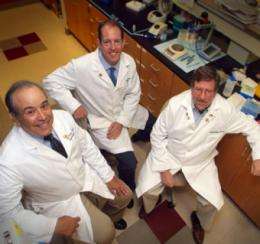Researchers work to turn back the clock on bone-producing stem cells

Researchers want to turn back the clock on aging stem cells so they'll make better bone.
Bone-weakening osteoporosis results in a fracture every three seconds worldwide, according to the International Osteoporosis Foundation. The right nutrients resulting in the right signals could help aging stem cells act more youthful, producing stronger bones longer and reducing the death and disability associated with a frail framework, Georgia Health Sciences University researchers say.
While many headlines scream obesity, about one-third of Americans age 65 and older are malnourished – it's called anorexia of aging – which means their bone-producing stem cells probably lack the right nutrition and signals to stay healthy and focused on their job, said Dr. Carlos Isales, endocrinologist and Chief of GHSU's Program of Regenerative Medicine. And even sufficient calories may not provide the right nutrient mix for aging bones.
Ironically, the easiest thing for bone-producing mesenchymal stem cells to make is fat, which is often what they resort to with age and inadequate nutrients. "Fat is the cheapest thing for your body to make. If it has to make muscle, that consumes energy, if it has to make bone or blood cells, that takes energy, so fat is the default pathway," said Isales, principal investigator on a $6.3 million Program Project Grant from the National Institutes of Health designed to help keep stem cells on the right track.
He and colleagues Dr. Mark W. Hamrick, a bone biologist, and Dr. William D. Hill, a stem cell researcher, are taking on the problem from multiple angles.
They believe a key group of amino acids, found in good supply in protein, can help generate the signals stem cells need to keep producing bone. Bones cells have surface sensors for these nutrients and the researchers want to know how those change with age and which nutrients are their best activators.
These nutrients are in addition to the vitamin D and calcium typically associated with growing strong bones.
"There is a whole litany of things that go into the pattern of appetite, food intake, normal response to food intake, secretions after food intake and normal cell response to those signals," Hamrick said, and at least some of these appear altered with aging.
The researchers also believe the satiety hormone leptin can help signal aging stem cells that they have enough energy to keep making bone, Hamrick said. A third, related angle is that high levels of the cytokine stromal-derived factor 1, or SDF-1, will help keep cells in the bone marrow, Hill said. Leptin levels appear critical to positive SDF-1 activity because when leptin levels decrease, as they typically do with age, levels increase of an altered SDF-1 type that actually calls cells out of the bone marrow.
While it's normal for mesenchymal stem cells to help out in other parts of the body, for example to respond to an injury, the aging cells seem to randomly wander and may die before they can get back home, Hill said. They may also start depositing fat in strange places including the bone marrow, liver and muscle where it can be destructive and even deadly.
Solutions may be as simple as a drink rich with the right amino acids to prevent these losses or as complex as genetically engineering SDF-1 to treat existing disease, the researchers said.
"We are hoping that ultimately it can be preventative, so you don't lose bone and muscle mass in the first place," Hill said. "The other thing is to see if we can help rescue old bones that are brittle and no longer creating high levels of bone formation."
They've already shown that aging mice on a low-protein diet can maintain healthy bones with an amino acid supplement. Isales is looking at 16 of the 20 most common amino acids to find the optimal combination. "Ultimately, what we would like to do is give amino acid supplements to patients, especially to hospitalized patients where you see the highest rates of malnutrition," Isales said.
Hamrick is looking downstream at leptin-mediated signals in the bone and muscle to better define leptin's role in making both, how signals change with age and which ones respond well to leptin treatment. He thinks he'll find molecules that may be targeted therapeutically and may also be used as frailty biomarkers.
Meanwhile, Hill is focusing on the "microenvironment" of stem cells, primarily the role of SDF-1 as a sort of homing signal for mesenchymal stem cells. "It's like having a standing army somewhere to protect the homeland but you have to call them out periodically to help out in other places and if they can't be replenished at home, eventually it exhausts that army."
As a bonus, if they figure out how to make the cells happier and healthier at home, they will be better backups when needed elsewhere. "Some of the wear and tear we experience as we age is the result of these cells no longer being available to help patch things up," Hill said.
With osteoporosis, the normal balance of bone production by osteoblasts (made by the mesenchymal stem cells) and bone removal by osteoclasts errs on the side of bone loss. Muscle health, which is tied to bone health as well as agility, also suffers, Hamrick said.
Without better options, Isales, who treats osteoporosis, expects patient numbers to continue to grow. "We are living longer and unhealthier," he said. "Our nutrition is generally terrible; we are all eating things we should not be eating." In fact, up to 35 percent of patients over age 60 eat a diet that is protein- and calorie-deficient, according to the National Health and Nutrition Examination Survey of the Centers for Disease Control and Prevention. Osteoporosis also has a strong genetic component. "If your mother had osteoporosis, you are at risk for it no matter how much exercise you get or vitamin D you consume, so genes are an important part of this," Isales said.














